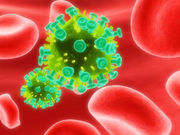HIV-infection, T cell activation linked to decreased number of osteogenic precursors
WEDNESDAY, June 15, 2016 (HealthDay News) — HIV infection with T cell activation is associated with lower bone mineral density (BMD) and stiffness, according to a study published online June 10 in the Journal of Bone and Mineral Research.
John S. Manavalan, M.D., from the Columbia University Medical Center in New York City, and colleagues used dual X-ray absorptiometry (DXA) and high-resolution peripheral quantitative computed tomography (HRpQCT) to characterize BMD and microarchitecture in 38 HIV-infected men on antiretroviral therapy (18 perinatally-infected and 20 adolescence-infected) and 20 uninfected men aged 20 to 25 years.
The researchers found that, compared with uninfected men, HIV-infected men had lower DXA derived areal BMD Z-scores and HRpQCT derived volumetric BMD measures. HIV-infected men had higher proportions of activated and senescent CD4+ and CD8+ T cells compared with uninfected men. HIV-infected men had a lower percentage of circulating osteogenic precursor (COP) cells than uninfected men (0.19 ± 0.02 versus 0.43 ± 0.06 percent; P < 0.001); the proportion was also lower in perinatally- versus adolescence-infected men (0.15 ± 0.02 versus 0.22 ± 0.03 percent; P < 0.04). Higher bone stiffness was seen with a higher proportion of COP cells, while a higher proportion of activated CD4+ T cells was associated with decreased BMD and stiffness and a lower proportion of COP cells.
“T cell activation with HIV-infection was associated with decreased numbers of osteogenic precursors as well as lower peak bone mass and bone strength,” the authors write.
One author disclosed financial ties to Gilead and AbbVie.
Copyright © 2016 HealthDay. All rights reserved.








